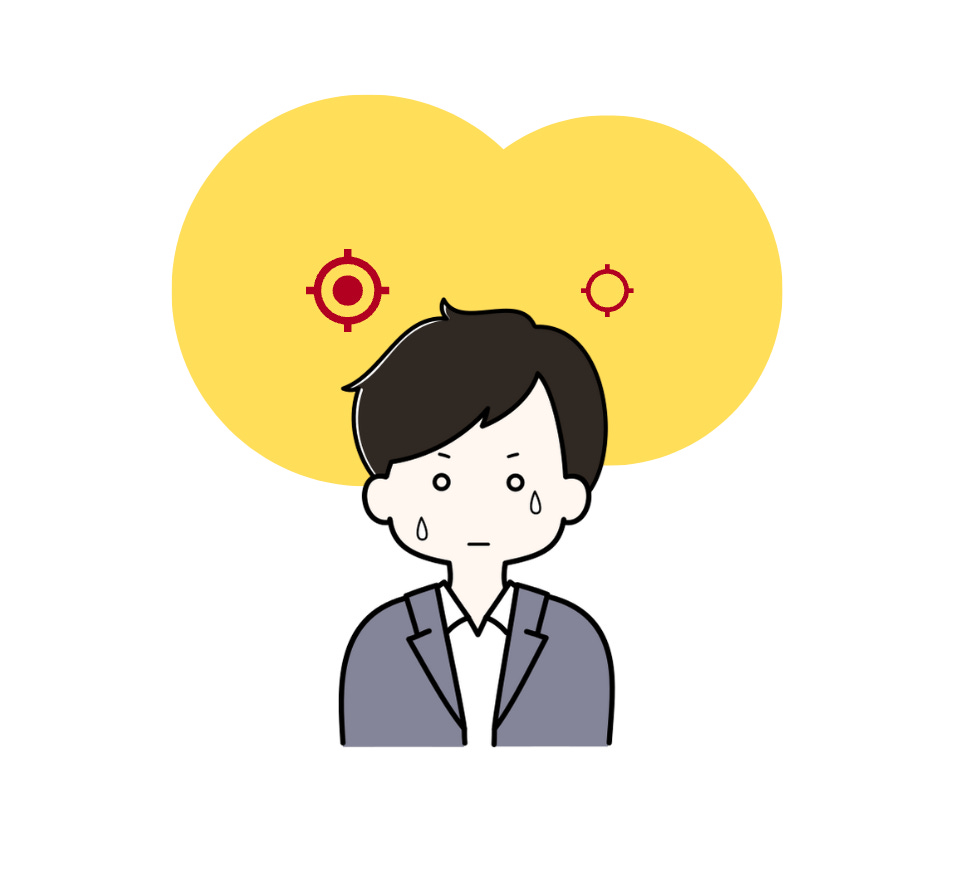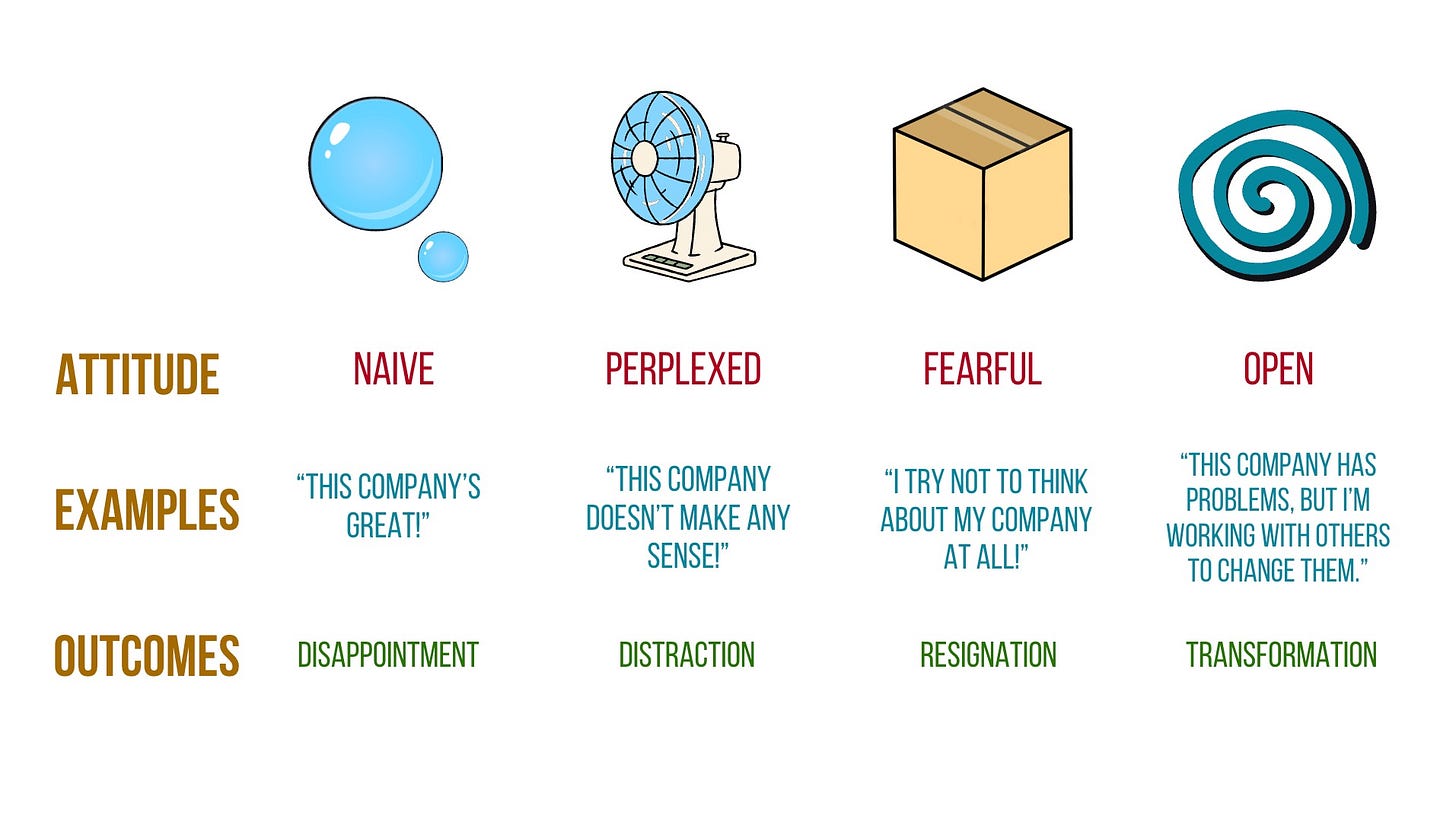Forgive the language, but every job, at some point or another, will give you Oh Sh—t Moments. Let’s call them OSMs, these sickening realizations that your job is broken.
As an open shape, the spiral is a pretty good guide for how to grow and rise through the imperfections of your company’s culture. More on that below.
What’s it feel like to experience an OSM? I have an analogy for you. Last week, my partner was doing some yard work when she spotted a long lateral crack in the foundation of our home. That’s right, the home we’d purchased less than a year ago. We called up a company, and the price they quoted gave us a full-on OSM.
That’s a parable. But for you, OSMs can be a workplace reality that feels like a slow-burn panic attack:
Sales are down in Q4, but not to worry! Nobody’s talking about it. Nothing to see here!
Hey, your vice president is a master of one-way communication! And what did you say? She doesn’t read response emails? That’ll save time!
Hmm, your working group is full of Enneagram 4s. And you’re—what?—an 8?
Oh look, your organization has a reputation for eco-unfriendly products!
What a super guy your manager is! Not great that he’s a part-time bigot, but, you know.
Your OSM, whatever it is, confronts you with a rottenness that you can’t un-smell in your company culture. Sometimes, it’s so bad that an OSM means you need to leave your job. If you’re suffering harassment, if the accountants are lying, if the company’s dumping bad stuff in the river, just go.
But if your company’s not GameStop or Wells Fargo or some other astonishingly red-flag-ridden company, why, you just might have a few moves to make. I call these moves the bubble, the fan, the box, and the spiral.
The Bubble. Taking a job at your company means entering into the circle of some workplace community. And I bet that move, at least at first, feels pretty good. The brand is bright and shiny; the team is amazing; the HR manager knows how to smile. You are looking at your job through the gauzy, rainbow-soapy sheen of a bubble. I mean it when I say you should enjoy this stage of getting to know your workplace.
Look, it’s all too easy to look down on people living in naiveté. But there’s something right about the bubbalicious vision of work: workplaces should feel enfolding and kind of gorgeous.
But then comes the OSM, and the bubble bursts.
When a bubble collapses, you’re left standing in the middle of a soapy circle. No, wait, that’s not right. Let me summon tenth-grade geometry for a minute. So, circles are planes arranged around a single point. (Do I have that right?) But in an OSM, your circle becomes an ellipse. If I remember ellipses correctly, they’re ovals with not one, but two points. Wait, whut? You mean there’s no single and consoling center point? You mean there’s a tension between opposing points?
But that’s what a workplace feels like after naive job satisfaction gets punctured. You realize, with a terrible clarity, that, sure, all those good things you thought were true are still sort of true. But alongside those truths, there are all these really sucky things that are also true. How can opposites both be true?
Your OSM has turned your circle into a tortured ellipse.
The Fan. When you’re living in an elliptical world, you’re forced to keep opposing realities in your head at the same time:
This job pays me well, but management never uses anyone’s pronouns.
The mission is great; the insurance sucks.
The CEO is a nice guy, but she’s calls herself color-blind.
The restaurant sources meat unsustainably, and all the advertisements greenwash like there’s no tomorrow. Which there might not be.
These contradictions are hard to manage. So, what practical people do is toggle constantly, exhaustingly, between the opposing points, oscillating like a fan pointing first one way and then another. Again, there’s something right about this move. Workplace wisdom does require you to keep seemingly opposed truths in your head.
But that perplexing toggle can reinforce what’s wrong with the company by distracting you from corrective action. Jenny Rice has written about this as a kind of shrug in political life, a what-can-you-do attitude that obstructs positive change. People say, “Sure, that’s no good.” But then they add, “But the other day I heard about a study saying the opposite, so—?”
The Box. When the OSM hits the oscillating fan, some people draw tighter boundaries. As Pooja Lakshmin argues, such boundary-setting might entail “making tough decisions for yourself and by yourself.” She goes on, “It starts with recognizing that you have limits, and you really do have to choose what you prioritize because just like everyone else, you are human.”
But there are boundaries, and then there are boxes. For some, it’s a Box of Denial allowing them to pretend that the tensions and contradictions of their company simply aren’t there. These people are basically building a stronger version of the bubble described above. Other people make a Box of Despair. Nothing’s ever gonna change anyway, so why worry about it. Just hunker down in your daily tasks.
We definitely need boundaries; but do we need boxes? Maybe for a little while. But how do you tell when you’re drawing boundaries or fabricating boxes? The tension reminds me of the challenges (discussed in a previous issue) of deconstructing and reconstructing deeply held beliefs. Brian McLaren has described in the life of faith and doubt, the movement from simplicity to complexity to perplexity and beyond. I find his framework encouraging: whether you’re inflating a Bubble, running a Fan, or building a Box, there’s still a kind of personal growth that’s happening. The movement from tidy circles to messy ellipses to rigid boxes represents a kind of maturation beyond naiveté.
But there’s still more growth that’s possible.
Try drawing a circle or an ellipse or a box on a sheet of paper: your pencil will start and end at the same point. That’s what I mean by a closed shape. It’s manageable. It’s predictable. It’s controllable. Sort of. But when the OSM arrives, you need an open shape. You need a way of doing your job—and doing you—that doesn’t start and end in the same place day after day. You need something less like a circle and more like a spiral. (Sorry about all the geometry this week.) The great thing about a spiral is that it transcends without escaping. All the turns you have taken in your storied career are gathered up in a rising convergence.
Julia Belcher helped me see the movement from bubble to fan to box and beyond, when she talked about her first real job out of college. As a graphic designer for a gun distributor in Jeffersonville, Indiana, she often felt lucky to have the job. Does that feel like a bubble in the making? But Julia seems aware of the elliptical world she’s hired into: the workplace community is great AND it’s not keen on her progressive political commitments. So, she has to run that oscillating fan a bit. But has she walled herself off from her coworkers? Nope. No box of denial or despair for her. Julia says she’s glad to be a corporate graphic designer but that, for now anyway, she’s keeping parts of herself on the down low. This practical boundary-setting have, I think, set her up well for a spiral upward into wise and meaningful vocation in her next job.
That’s the mode/switch for this week. When your next Oh Sh#t Moment happens at work, let naiveté and cynicism fall away. Opt for growth instead.
- craig









